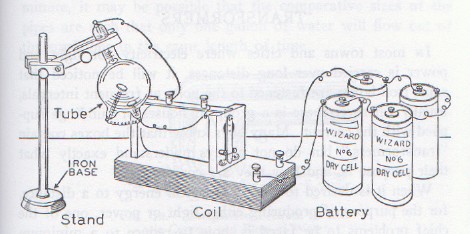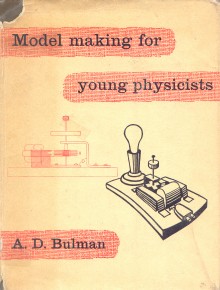
featuring
Mad Teddy's electrical / electronic projects
While at high school in the mid-1960's, I found in the school library some
books which grabbed my interest. Three, in particular, had lots of
electrical "things to make and do".
One of these books was "The Boy Electrician" by Alfred P. Morgan. This was
already an old book even then, having been revised in 1940 from a book by
J.W.Sims which was published in 1920 (or possibly even earlier - there seems
to be some confusion about this).
"The Boy Electrician" was a "WOW!"-type book for boys looking for something
exciting to do. (In those days, presumably, girls weren't - or, at least,
weren't supposed to be - interested in doing exciting things!)
For me, the most interesting things in the book were instructions for making
a Wimshurst machine, an induction coil, and what we would now call a bipolar
(or half-wave) Tesla coil.
There was one thing in this book that caused me to raise an eyebrow, even in
my early-to-middle teens. In Chapter XII, "INDUCTION COILS", there was a
section on X-rays, which was introduced as follows (thanks to
Lindsay Publications
for permission to include this here):
Most young experimenters are unaware what a wonderful and interesting field
is open to the possessor of a small X-ray tube. It is possible to obtain
small X-ray tubes which will operate satisfactorily on an inch and one-half
spark-coil. They usually cost about four dollars and a half. With such a
tube and a fluoroscope it is possible to see the bones in the human hand,
the contents of a closed purse, etc.
OH, YEAH?
Bulman's book had instructions for making numerous projects, not all of
which were electrical in nature - for example, a Cartesian diver and a
harmonograph, both of which I attempted. Again, however, the most exciting
projects for me were the electrical ones.
Several of Bulman's projects looked like updated versions of similar items
in "The Boy Electrician", which I suspect he may have read in his own youth.
However, there were some originals as well. Definitely a worthwhile book.
The third of the three books was in fact, if I remember correctly, the first
of the three that I found. Sadly, I've forgotten both the name of the book
and the name of its author. (As a youngster, it would not have occurred to
me to take note of the publisher!) Let's just call it Book X. It was of a
basically similar type to Bulman's book. I seem to recall that the cover
was essentially yellow, perhaps with some drawings in black illustrating
some of the book's contents.
Book X contained some things in common with the other two. All three gave
instructions for making a simple two-pole electric motor. There may have
been plans for a Tesla coil in Book X, but I'm not sure. There may also have
been a version of Hero's engine, which would have involved a bit of
glass-blowing, similar to Bulman's Cartesian diver.
Anyway, among these books, there was plenty to interest me. Some of the
projects in this website are based on ideas from all three.
Just before we start - two matters:
1.
I asked my Dad if he would buy a copy of "The Boy Electrician" for me. He
did find one - but it was nothing like the 1940 version!
It claimed to be "completely revised from the original book by J.W.Sims". It
was written by "ARMAC", apparently a two-author consortium, and published by
George Harrap and Co. Ltd. in 1965. It called itself the "eighth edition".
It was a dryer, much more sober work. In the preface, the following sentence
appeared:
"Every care has been taken to avoid any work which might be dangerous to the
unskilled experimenter, or liable to damage the family furniture or
television set."
Oh, dear! How frightfully couth. It sounds to me like the beginning of both
political correctness and the litigious nature of modern society. Who needs
any of that?
Now, I'm all for safety first, as I'm sure you will see, if you haven't
already. But this is a real dampener, in my opinion.
Almost entirely gone is the sense of excitement. The electric motor is still
there; ways to soup-up your model railway are there; and the new age of the
transistor is upon us, with some quite reasonable simple circuits to build.
But! Gone are the Wimshurst machine, the home-made induction coil, and the
Tesla coil - not to mention the "shocking coil", which made it not only into
Morgan's book (as the "medical coil"
Also, you may be sure there is no mention in the "eighth edition" of
home-built X-ray machines!
I'll confess, I was disappointed. But I kept the book; and I'm glad I did,
for two reasons:
Firstly, some forty years on, it is in itself a historical document,
providing some insight into how the modern electronic age started in the
1960's; and thus it's interesting from that point of view.
Secondly, a few years ago (2002), I found that Morgan's 1940 edition had
been reprinted by
Lindsay Publications Inc
, as a
modern paperback
and with some grim warnings regarding safety, but with everything in it
that should be - including the X-ray machine! You may bet I ordered a copy
for myself pronto - so now I have both versions of the book!
(Have a good look around Lindsay's site. I'm not being paid anything to plug
their products, but the site itself is very entertaining, and there is
plenty there to make you chuckle. Also,
this site
is worth a look; among other things, there is a photograph of the new
paperback version of Morgan's lovely old 1940 book. Again, I'm not
advertising - only reviewing!)
UPDATE, Sunday, 1st December 2013
I've just revisited the Lindsay site for the first time in ages. It's still there - but now there's only a "farewell" page,
explaining that the site has been "shut down for retirement". (Pity - it was fun...)
However! All is not lost. By clicking on a few links, I found that it's now possible to download the original Alfred P.
Morgan book "The Boy Electrician" as a .pdf file. How good is that?!! Click
here
and follow your nose to the download link. (An interesting aside: if I'm reading it right, that page's author has
Asperger's Syndrome. Nice to find a kindred spirit...
One really good thing did scrape into the "eighth edition", though. There is
a description of how to have some fun with an ignition coil! My Dad brought
home such a beast, and we built it into a nice "sparky" little project,
which I still have - and, yes, you will find it within this website.
2.
Sometimes in life, you get lucky.
Some years ago, I was relief-teaching at my old high school. As part of the
day's activities, I was in the school library with a class.
The staff were going through the library's old books, with a view to
throwing some of them out. My eyes nearly popped out of my head when I saw
"Model Making for Young Physicists" by A.D.Bulman - my old friend -
destined for this tragic fate!
I asked if I could have it, and the answer - to my huge delight - was "yes".
Oh, joy!
Here it is, somewhat old and battered, but now among my treasured
possessions. (You can click on it to see a bigger version.)
You will find a description of my own version of the little gadget depicted
on the front cover, called a "synchronous wheel" by Bulman, elsewhere in
this website. (If you click on Electromechanical models on the following
menu, you will find a sub-menu with a link to it on the next page).
(Thanks to
John Murray
for permission to include this.)
Sadly, I didn't see either Morgan's "The Boy Electrician" or Book X among
the books doomed to perdition. Anyway, as I mentioned, I now have the latest
printing of Morgan - so, as the fat guy said, two out of three ain't bad!
One of the good things about physics experimentation at a "serious hobby"
level is that it's possible to make some quite fascinating projects from
bits'n'pieces that most people would classify as "junk". You can find much
of what you need in "junk shops". (An occupational hazard of this sort of
activity, of course, is that you may well become a "hoarder".
If you're lucky (as I must admit I have been), you may find quite a lot of
useful things just "lying around". Occasionally, you may need to visit your
local electronics outlet or other shops for some components; the best
satisfaction, however, comes from building one's masterpieces as cheaply as
possible. This is the philosophy I'm trying to promote in these pages.
ELECTRICAL STUFF
Super-magnets: old problem, new solution
Electromagnetism - an introduction
My incredible old power supply
Possible future addition: Miscellaneous electronics projects.
My home page
Preliminaries (Copyright, Safety)
Electrical stuff



Another of these books was "Model Making for Young Physicists", by A.D.
(Alan Davidson) Bulman, published in 1963 by John Murray.

 ), but into Bulman's book as well!
(Yes, you will find a version of this little beauty right here in this
website - complete with suitable warnings.)
), but into Bulman's book as well!
(Yes, you will find a version of this little beauty right here in this
website - complete with suitable warnings.)
 )
)

 )
)

 MENU
MENU



 Return to Main menu
Return to Main menu


